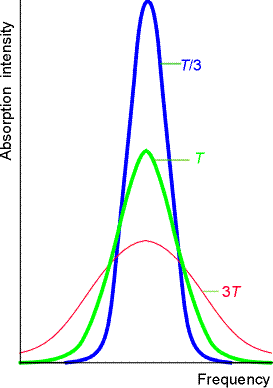
A standard way of defining the width of an emission line is to use the
full-width at half-maximum:
In reality, a line profile is the result of several processes and effects. Here we will assume a Gaussian shape and assume that the profile is due only to the motions of the atoms in the gas. For a gas of atoms moving with a thermal energy distribution, the line has a "Doppler profile," and the FWHM can also be called the "Doppler width." More details on the Doppler profile can be found here. The FWHM, Δλ, of a spectral line emitted by such a gas is related to vaverage, the average speed of the atoms producing it by:
The higher the temperature of the gas, the broader the FWHM:

The Doppler width arises from the differing radial velocity components of the emitting atoms. These differences are due to both the atoms' varying directions of motion in the gas and the distribution of speeds among the atoms. You learned in class how the temperature is related to the average kinetic energy of the particles in the gas and that equipartition of energy mandates that all kinds of atoms have the same average kinetic energy.
Now imagine you have a nebula with a typical composition: let's say it contains H, He, C, N, O, Ne, S, and Ar, and all of these elements produce observable emission lines. Assume that the nebula is isothermal (all at the same temperature). Also consider only the nuclei of the atoms; ignore electrons.
1. At a temperature of 10,000K what is the average kinetic energy of a hydrogen atom (i.e. a proton)? A helium atom? All the kinds of atoms in the nebula?
2. At a temperature of 10,000K what is the average speed of a hydrogen atom (i.e. a proton)? A helium atom? A sulfur atom? (To do this calculation, assume that the square root of the average v2 equals the average v.)
3. Describe quantitatively the trend in FWHM values of emission lines produced by all the elements above.
4. Now turn the calculation around and describe how you could use it in principle as a nebular thermometer. Which lines would you want to observe?